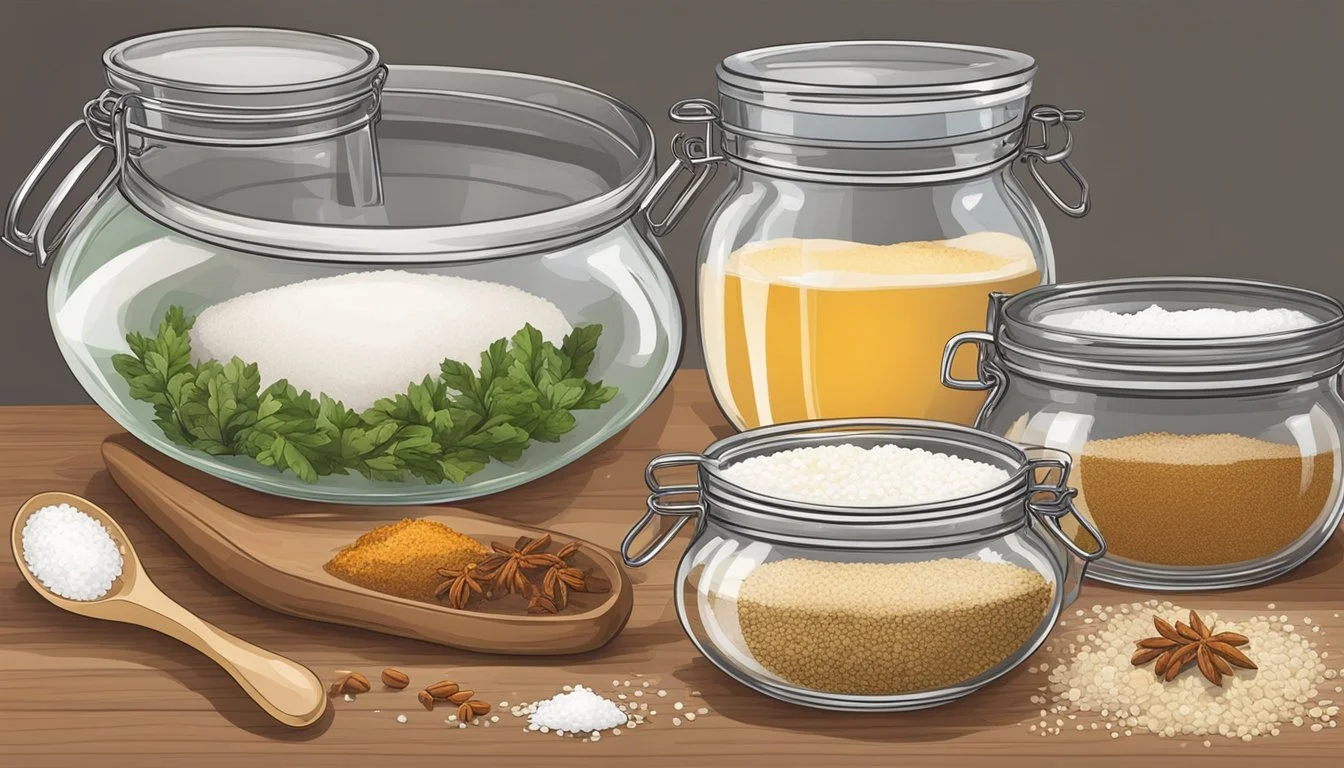How to Ferment Salo
Mastering Eastern European Cured Fatback Techniques
Salo, a cherished delicacy in Ukraine and widely recognized across Eastern Europe, is the name given to a traditional type of cured pork fatback. Not to be confused with regular lard, which is rendered fat, salo retains its solidity and is consumed mainly in its raw, cured form. Esteemed as a national dish and a significant part of regional culinary heritage, salo is often savored for its rich textures and flavors that result from the fermentation and curing process.
The art of fermenting salo involves a meticulous process of curing, which typically includes the use of salt as a primary preserving agent. Occasionally smoked for added depth of flavor, salo is a versatile ingredient that can be enjoyed on its own, typically with a slice of rye bread, or used to enhance various dishes. The curing method not only preserves the fatback but also imparts a distinct savory profile that is both subtle and profound, making it a highly regarded fixture on the Eastern European table.
Crafting salo requires patience and adherence to traditional techniques that have been passed down through generations. With roots deep in Ukrainian food culture, the proper fermentation of salo is vital to achieving the characteristic texture and taste that this culinary staple is known for. While the process may vary slightly from region to region, the fundamental principles of curing remain consistent, ensuring that salo maintains its iconic status among the gastronomical treats of Eastern Europe.
The Basics of Salo
Salo, a staple of Ukrainian cuisine, is essentially cured pork fatback highly regarded as a national food and cherished snack throughout Eastern European and Slavic countries.
Understanding Salo
Salo is derived from pork fatback, a thick layer of fat located under the pig's skin on its back. Unlike lard, salo is not rendered and is instead preserved through curing processes involving salt, and sometimes additional spices and garlic. It is typically consumed in its solid form, often served thinly sliced and paired with bread.
Historical Significance
Historically, salo has served as an essential source of sustenance, especially during the cold months when food preservation was a significant challenge. Its method of preparation allowed Eastern Europeans to store food for extended periods without refrigeration, contributing to salo's prominence in regional culinary practices.
Cultural Relevance
Salo holds a special place in Ukrainian culture where it is often considered more than just food – it's a symbol of hospitality and a treasured delicacy. In various Slavic countries, salo goes by different names, such as slănină in Romania and szalonna in Hungary. Across these nations, salo typically accompanies traditional festivities and family gatherings, signifying its cultural importance.
Ingredients and Supplies
Creating traditional Eastern European Salo involves a careful selection of both ingredients and equipment. Specificity in ingredients ensures the desired flavor profile and texture, while the correct supplies maintain the process's integrity and safety.
Essential Ingredients
Fatback: This is the primary ingredient. One needs a sizable piece of pork back fat, of high quality and preferably with no lean meat.
Salt: It plays a crucial role in the curing process. Use kosher salt or another non-iodized salt to avoid imparting any unwanted flavors.
Garlic: Fresh garlic cloves are crucial for adding depth and a pungent aroma. They should be peeled and finely chopped or crushed.
Black Pepper: Freshly ground black pepper adds a spicy kick. Peppercorns can be used whole for a milder effect or ground for more intensity.
Supplementary Ingredients
Bay Leaves: These are usually crushed and sprinkled over the fatback to infuse it with their distinctive, herbal flavor.
Sweet Paprika: This provides not only a gentle warmth but also a vibrant red color to the finished product.
Coriander Seed: Used for their lemony citrus flavor when crushed, they complement the fattiness of the Salo.
Fennel Seed: Their slight aniseed flavor adds a unique twist to some Salo recipes.
Tools and Equipment
Cutting Board and Knife: A sturdy board and sharp knife for prepping the fatback.
Large Glass or Ceramic Container: Salo is cured in a non-reactive container to avoid any metallic taste.
Mortar and Pestle or Spice Grinder: To crush or grind the spices such as peppercorns, coriander, and fennel seeds.
Butcher's Twine (optional): If one intends to hang the Salo during the curing process, twine is necessary.
Refrigeration Unit: An essential tool for keeping the curing environment at a consistent, low temperature to prevent spoiling.
Preparation Guide
This guide provides the essential steps for fermenting Salo, an Eastern European delicacy of cured fatback. It outlines how to clean the raw pork fat, apply the cure, and explore flavor variations.
Cleaning the Fatback
The first crucial task is to clean the fatback thoroughly. One must:
Remove any remaining hair or dirt from the skin, if present.
Trim excess meat or blood spots to ensure a uniform piece of fat.
Applying the Cure
For curing, a dry salt or salt-curing method is preferred. The process involves:
Generously rubbing the fatback with dry salt (coarse or kosher) to cover every surface.
Placing the salt-covered fatback in a clean container to cure at a cool temperature.
Adding Flavor Variations
While a basic cure is often enough, many opt for additional flavors. One can:
Introduce spices like black pepper, paprika, or crushed garlic into the curing mixture for a complex flavor profile.
Experiment with smoked salo by adding a cold smoking step after the initial dry cure for an added depth of flavor.
Curing Process
The curing process is a critical step in creating Salo, involving the application of salt to preserve the pork fatback. It can be done through a dry cure or wet cure method, both of which inhibit bacteria growth and enhance flavor.
Dry Curing Method
Dry curing involves rubbing a mixture of salt and sugar onto the fatback. One starts by layering the mixture onto the meat thoroughly, ensuring every part is covered.
Ingredients: The basic dry cure consists of:
Salt: Typically a coarse option such as kosher or sea salt.
Sugar: To balance the saltiness and promote desirable bacteria.
Steps: The process is as follows:
Mix the salt and sugar together.
Coat the fatback evenly with the cure mixture.
Place the meat in a container, separating each piece to ensure the cure penetrates evenly.
The meat is then covered and stored in a cool place for a specific period, often several days to weeks.
After curing, the meat is rinsed and wrapped in cheesecloth to dry, often in a cool, ventilated area.
Wet Curing Method
Wet curing Salo, on the other hand, involves immersing the fatback in a brine solution, a mixture of water, salt, sugar, and sometimes additional flavorings.
Brine Composition: A basic wet cure brine includes:
Water: As the medium of the cure.
Salt: It should be fully dissolved in the water.
Sugar: To offset the harshness of the salt.
Procedure:
Dissolve salt and sugar in water to create the brine.
Submerge the fatback completely in the brine.
The meat remains in the brine, refrigerated, often for a few days to a couple of weeks, depending on the desired saltiness and size of the fatback.
Once cured, the meat is removed, rinsed, and then dried, sometimes employing cheesecloth for aeration.
In both methods, after salting, the Salo can then be left to ferment in a cool, controlled environment to develop its unique flavor profile before consumption.
Aging and Storage
Proper aging and storage are crucial for the quality and flavor of salo, the traditional Eastern European cured fatback. Correct methods ensure it develops the intended taste profile and texture, while also preserving it for longevity.
Aging Salo
After curing, salo needs to undergo a controlled aging process to reach its optimal flavor and texture. This process typically lasts from one to four months. The temperature during aging should be maintained between 2°C and 4°C (35°F and 39°F) with a relative humidity of 75% to 80%. These conditions help the salo mature without risking spoilage. Some enthusiasts may also opt to smoke the salo after curing to add a distinctive flavor. Smoking should be performed at a low temperature of around 225°F (107°C) for several hours to infuse the salo with a smoky aroma without cooking it.
Key Factors for Aging:
Temperature: 2°C - 4°C (35°F - 39°F)
Humidity: 75% - 80%
Time: 1 - 4 months
Optional Smoking: ~225°F (107°C)
Storage Recommendations
Once aged, salo should be stored in a cool, dark place to maintain its quality. It can be wrapped in parchment paper or cloth and placed in a wooden box or a container in the refrigerator. The ideal storage temperature is just above freezing, as salo is best kept in conditions similar to those during aging.
Individuals keen on salo's history and traditions might appreciate the occasional exhibitions in salo museums, where the cured delicacy's cultural significance is celebrated.
Storage Guidelines:
Wrap: in parchment or cloth.
Place: wooden box or refrigerated container.
Temperature: Just above 0°C (32°F)
Serving Suggestions
When presented properly, fermented salo reveals its full gastronomic potential. Traditionally, it graces the table with simple accompaniments, enhancing its rich flavor. Modern culinary trends have introduced innovative pairings, offering a refreshing twist to this Eastern European delicacy.
Traditional Servings
Salo is often consumed in thin slices on a piece of rye bread or black bread, providing a delightful contrast of texture and flavor. A common addition is raw onion, either finely chopped or sliced into rings, which cuts through the fat's richness. In Eastern Europe, it is not uncommon to see salo accompanied by a shot of vodka, which is believed to balance the hearty fat with its crisp, clean finish.
Rye Bread: A sturdy slice acts as a base for the salo.
Onion: Crisp and pungent, it complements the creamy fat.
Vodka: Chilled, it offers a bracing counterpoint to the dish.
Pepper: Often sprinkled atop for a spicy note.
Garnishes: Include pickles or horseradish for added zest.
Modern Pairings
Chefs have been creative with salo, incorporating it into various dishes. A dollop of seasoned salo can be the perfect finish on a bowl of borscht, adding depth. It can also be diced and added as a savory component in varenyky (stuffed dumplings), marrying tradition with innovation.
Borscht: The cured fat enriches the iconic beet soup.
Varenyky: Salo fills or garnishes these stuffed morsels for a textural surprise.
Contemporary chefs might pair salo with a local craft beer or utilize it as a unique topping on gourmet pizzas or salads, showcasing its versatility beyond traditional uses.
Diverse Variations
Salo's preparation varies across regions, with each locale infusing its unique cultural flair into this traditional delicacy. These regional distinctions and flavorings ensure a rich tapestry of tastes within the overarching method of fermenting and curing pork fatback.
Regional Variations
Eastern European countries boast an array of salo types, each reflective of their respective culinary traditions. For example:
Ukraine: Salo is traditionally cured with salt and sometimes garlic, with an option to smoke it afterwards for added flavor.
Romania: Here it goes by slănină and often includes a layer of red meat beneath the fat.
Hungary: Known as szalonna, it is a staple that can be found smoked with a rich flavor profile.
Bosnia: Similar in preparation, their version may also include a smoking step.
Museums in some of these countries even celebrate salo, emphasizing its cultural significance.
Flavor Twists
While traditional methods focus on simple ingredients like salt and pepper, contemporary variations include a broader range of spices and herbs:
Italian influence: Borrowing from Italy's lardo, some chefs add herbs like rosemary and other aromatics to the curing process.
Garlic powder and pepper: These are common additives that infuse the fat with punchy, robust flavors.
Here is a quick reference for common flavor twists:
Ingredient: Garlic
Effect on Flavor: Adds a pungent, spicy kick
Ingredient: Black Pepper
Effect on Flavor: Introduces a sharp, hot note
Ingredient: Rosemary
Effect on Flavor: Infuses a piney, lemony profile
Ingredient: Applewood
Effect on Flavor: Smoked variants offer a sweet, fruity touch
By incorporating these variations, one can experience salo in a multitude of ways, each with its own distinct character.
Health and Nutrition
In discussing salo, an Eastern European cured fatback, its health and nutritional aspects are critical to understanding its place in the diet. This section explores the composition of salo and the potential health implications of its consumption.
Nutritional Profile
Salo is primarily composed of fat, specifically fatback, which is the hard fat from the back of a hog. Its nutritional profile is characterized by a high caloric content and significant fat content, with minimal protein and no carbohydrates. Salo's energy value comes largely from its fat, which can provide sustained energy. A typical serving of fatback can be high in both calories and cholesterol.
Calories: Salo is calorie-dense due to its high fat content.
Cholesterol: Like many pork products, salo can contain high levels of cholesterol.
Health Considerations
When incorporating salo into one's diet, several health considerations must be kept in mind. As salo is rich in lard, a type of fat, it is essential for individuals to consume it in moderation. The high saturated fat content can contribute to an increased risk of heart disease if consumed in large amounts. Additionally, those monitoring their calorie intake should be cognizant of salo's high caloric density.
Pork Belly (What wine goes well with pork belly?) vs. Fatback: Salo is typically made from fatback rather than pork belly, which is leaner.
Nutritious Balance: While salo itself is not particularly nutrient-dense, it can be eaten in a balanced diet.
It is important for consumers to consider the broader context of their dietary habits when evaluating the role of salo in a nutritious diet.
Frequently Asked Questions
In this section, readers will find answers to common concerns about fermenting salo, as well as expert tips to enhance the quality and flavor of this Eastern European delicacy. The following information addresses proper curing techniques and seasonings.
Common Concerns
Q: How long does it take to cure salo with salt?
A: Typically, salo requires at least one to two weeks to cure appropriately, depending on thickness and the desired level of firmness.
Q: Can salo be over-cured?
A: Yes, if salo is left in contact with salt for too long, it can become too hard and excessively salty. It's vital to follow specific treatment times.
Q: What are the risks of improper curing?
A: Insufficient curing can lead to spoilage and foodborne illnesses, while over-curing may affect the texture and taste adversely.
Expert Tips
Q: What's the ideal salt to use for curing salo?
A: One should use non-iodized salt, such as kosher or sea salt, for an even cure without imparting any unwanted flavors.
Salt Type
Kosher Salt: Often preferred for its flake size.
Sea Salt: Can be used for a more mineral-rich flavor.
Q: Are there specific seasonings recommended for fermenting salo?
A: Apart from salt, classic seasonings include crushed black peppercorns, bay leaves, and garlic. These should be finely ground and evenly distributed over the surface.
Q: What is the best surface to prepare salo on?
A: One should use a clean, flat cutting board for ease of preparation and to ensure even application of the curing mixture.
Q: Is there a tip for achieving the best flavor profile in salo?
A: Experts suggest gently massaging the seasoning mix into the salo to ensure thorough integration of flavors. This also helps in even absorption of the salt and spices.
Q: Where should salo be stored during curing?
A: It is important to store salo in a cool, dark place such as a refrigerator or a cold cellar to maintain an optimal curing environment.
Q: Can salo be cured in a restaurant setting?
A: Yes, many restaurants cure their own salo. They follow strict food safety guidelines and have a dedicated space for the curing process.
Beyond the Plate
When one considers Salo, they must acknowledge its significance both in the culinary world and its cultural prominence in Eastern Europe.
Salo in Cuisine
Salo, the salt-cured fatback, is a versatile ingredient in Eastern European cuisine. It can be used in a variety of dishes or consumed on its own, usually thinly sliced and often accompanied by rye bread. In Ukraine, Salo often finds its way into national dishes, adding depth and flavor. Lviv is particularly renowned for its Salo, often serving it as part of festive meals or incorporating it into everyday cooking.
Bulgaria: Salo serves as a hearty addition to traditional recipes, contributing rich flavor.
Belarus: In Belarusian cuisine, Salo is a staple, sometimes smoked for enhanced taste.
The Cultural Impact of Salo
The cultural importance of Salo extends far beyond the kitchen. It is an integral part of social rituals, representing hospitality and a connection to historical practices across several countries including Ukraine and Belarus. A Salo museum exists in Ukraine, showcasing its prominence and celebrating its role in national heritage.
Salo Museum: The museum is a tribute to Salo's impact on Ukrainian culture.
National Dish: Salo is more than food; it is a symbol of local tradition and pride in countries like Ukraine.
In these societies, Salo is a testament to culinary heritage and a touchstone for national identity.









